Wood Firing Weekend at Mid Wales Arts Centre
- Harriet Ridley

- Mar 12
- 4 min read
Updated: Jun 6
March 2025

For as long as I have done pottery, I have wanted to take part in a wood firing.
There is something about the alchemy of it—the way flame and ash transform the clay and glaze, leaving their marks in a way no hand could. I wanted to be part of the process, to stack the kiln, to tend the fire, to wait. And I am not alone; many potters and ceramic artists are drawn to wood firing for its unpredictability, depth, and sense of connection—to the process, the materials, and the history. Unlike electric or gas kilns, which offer control and consistency, a wood-fired kiln allows the fire itself to shape the work. Ash settles on the pots, flames scorch the clay. No two pieces emerge the same.
At risk of further romanticising the process, there is also something ritualistic to it— hours of stoking, teamwork, and a feeling of being part of something quite elemental. In comparison, my electric kiln feels a bit like turning on the toaster. I've heard that many potters love the sense of surrender wood firing requires, the giving up of control, and I can attest to that. You do your part—shaping, glazing, stacking the kiln—but in the end, it is the fire that will finish the work. When it goes well, the results can be spectacular.
The Girel 3e kiln is an ergonomic, economic and environmentally friendly kiln designed by French ceramicist Jean Girel in 2022, and built in 2024 by Jean Sampson (MA), Alison Finnieston (MA) and Evan Jones (MA) at the Mid Wales Arts Centre near Newtown, Powys. The kiln uses less wood than comparable kilns and fires in less time. We were able to load the kiln on Friday afternoon, candle it gently overnight, and then fire to cone 9/10 the following day in just shy of 14 hours. We were able to open the kiln on Sunday early afternoon. The firing was run by Jean and Alison, and there were six of us pottery enthusiasts along for the ride. I believe spaces are still available to join the remaining firings planned for this year.
The firing
Some photos below of the firing. Simply click to expand the image and caption. If viewing on a phone, you'll need to orientate the phone to landscape to read the full captions.
Click photos for captions.
The pots
In the week following the firing, I spent some time photographing and studying my pots. A lot of learning in ceramics comes from reflecting on finished pieces. After a conversation with Jean over the weekend about questioning the work we produce, I challenged myself to really consider both what I liked and didn't like about each piece, and to explain my thoughts from both a technical and aesthetic standpoint. Lots to fill my notebook with. I hope that this exercise will inform any wood firing I do in the future, and also help me to shape the aesthetic principles I want to follow in all of my work.
Additions of Ash
By nature of the firing process, ash from the burning wood is forced around the kiln by the heat and flames. Some of this lands on the pots and acts as a natural flux that influences the formation of the glaze. I wanted to explore the potential of ash further and experimented with raw ash from a friend's wood kiln, adding it over the top of the glazes and spraying it onto pots raw. The pots below all have some addition of raw ash. Layered over Jean's Shino glaze (on the teapot and lidded pot) the ash melted to a smooth surface with some crystallisation, which is beautiful.
Shells
Of all the draws to wood firing, the mark of shells has been the most enduring for me. Used as wadding in the firing, they leave a delicate ghost on the final pot. At first the marks might seem like imperfections—a scar, a flaw, an interruption in the surface—but to me they feel ancient and I love what they imply. They show how the pot lay in the kiln, how it was touched and transformed. They are evidence of before and after. Oh, the analogies to life abound! I have often considered trying to use shells in my electric kiln, and after this weekend’s wood firing, I have the confidence to try.
A Few Favourites
Moving Forward
If I was to do another wood firing, there are a few things I would like to resolve and explore. Some are within my control, others are not. Jean provided some lovely and reliable glazes for us to use, though as a potter who makes and tests my own glazes, it felt a little unnerving to work with unfamiliar recipes! I noticed some issues with glaze fit on my clay, which I would want to address for future firings. This would likely mean developing and bringing my own glazes—and would provide an opportunity to indulge my long-standing love affair with celadon.
I would also like to try both a porcelain and a darker-burning body for this type of work, as the Staffordshire Stoneware I use in my electric kiln felt quite bland at times. I could also explore a flashing slip to create some surface excitement. I'd like to also experiment with layering glazes more effectively, following the success of the side-fired lidded jar.
As for things I can't control, I would love to see the effects of more flame and ash on the pots. A few of mine emerged looking much as they would have done from an electric stoneware firing. Beyond a longer and more intense firing, I'm not sure how that could be achieved. I would be interested to talk more with the guys at MWA for their thoughts and to learn from their experience of wood firing.
Finally, I want to pay closer attention to light and shadow in my work. It struck me when photographing the pots how beautifully the square cut bowls and dishes cast shadow beneath them. Likewise, I tested a new mug shape that did something similar. I like how the idea of shadow could also be linked to the marks left by shells, or the interrupted spraying of a glaze. Thoughts for the future.








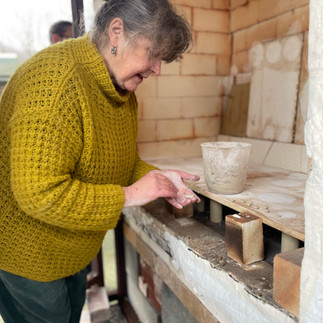

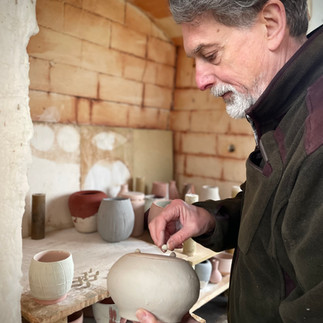




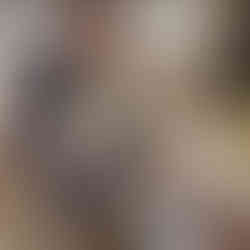





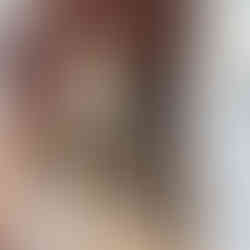














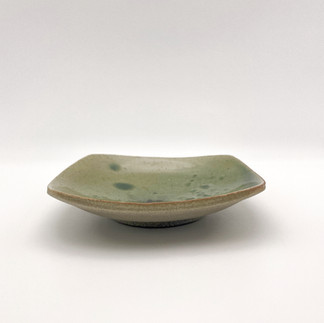














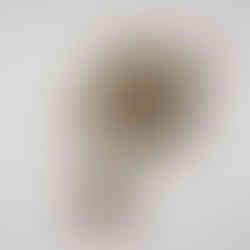














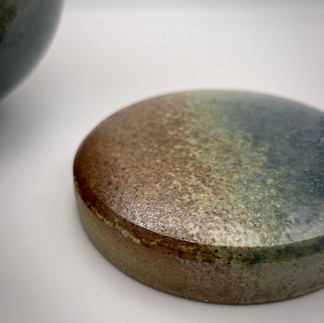

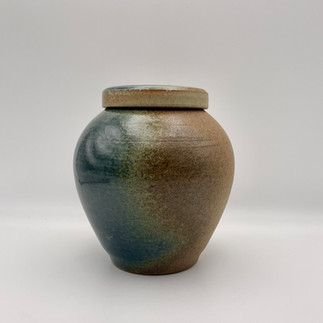



















Thank you Harriet. I love your comments on the wood firing and your work beautifully illustrates the myriad effects that ash and fire can have on clay. Hopefully we will see you again sometime at Mid Wales Arts Centre.
Hi Harriet, what a lovely thoughtful piece of writing, much to think about.
One thing we can improve on is the kiln pack, as a bit counter intuitively, the kiln fires best with a dense pack, certainly at the top which is when we start flagging! I am building up a collection of 'fillers' which might help. Another thing, which might affect glaze fit, is that it is best to let pots dry after glazing interiors as dampness will inhibit the thickness of the outer glaze. On closed forms this could be done before coming to MWA, I will suggest this in future. We learn with every firing,
Your pots and pictures are beautiful.